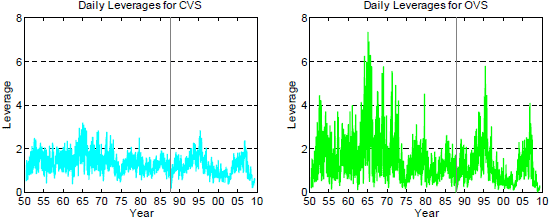There is a stream of research finding that asset price volatility is much more predictable than returns. Is there a way to extract economically meaningful gains from the predictability of volatility. In his March 2010 paper entitled “Alpha Generation and Risk Smoothing using Volatility of Volatility” (the National Association of Active Investment Managers’ 2010 Wagner Award winner), Tony Cooper investigates dynamic leverage as a means to exploit volatility predictions by applying higher (lower) leverage when returns compound rapidly (slowly). Just before the close each trading day, he executes an algorithm to predict the volatility for the next trading day and adjusts leverage for that predicted volatility at the close. Using daily closes of several broad stock market indexes (excluding dividends) spanning 1885-2009, he finds that:
- Leverage timed to volatility predictions generally increases (decreases) exposure to the market return at the right times.
- Simple strategies for translating daily volatility predictions into daily leverage allow setting sensitivity to predicted volatility and targeting overall portfolio volatility.
- Such strategies boost gross returns by increasing leverage when market volatility is predictably low and decreasing it when market volatility is predictably high (see the charts below). Specifically:
- The strategies smooth the cumulative return profile by reducing the volatility of portfolio volatility.
- If constrained to the market volatility, the strategies enhance gross returns in bull and sideways markets and do no worse than the market in bear markets.
- If constrained to leverage no greater than one, the strategies greatly reduce portfolio volatility without significantly reducing gross returns.
- The strategies specify very low leverage during the October 1987 crash.
- An investor could perhaps implement the strategies via combinations of leveraged Exchange-Traded Funds (ETF) from a family of such funds, at the cost of a typical annual management fee of 0.95%.
The following charts, taken from the paper, plot the leverage specified by two strategies for exploiting the predictability of the volatility of the S&P 500 Index over the period 1950-2009. The Constant Volatility Strategy (CVS) strategy applies daily leverage according to a constant divided by the predicted next-day volatility. The Optimal Volatility Strategy (OVS) applies daily leverage according to a constant divided by the square of the predicted next-day volatility. The value of c determines the overall portfolio volatility (for example, here constraining it to the unleveraged market volatility). The OVS strategy is more sensitive to predicted volatility than the CVS strategy.
Casual inspection indicates that these strategies tend to increase (decrease) leverage during bull (bear) markets. Applying the leverage series of the CVS and OVS strategies to the S&P 500 Index Index generates annual gross returns of 10.1% and 12.1%, respectively, compared to 7.0% for the unleveraged index.

In summary, investors may be able to exploit the predictability of equity return volatility via a dynamic leverage strategy that increases (decreases) leverage when predicted volatility is low (high).
Note that the cost of implementing dynamic volatility during much of the backtest period would have been very high due to lack of derivatives and relatively high trading frictions (see “Trading Frictions Over the Long Run”). An investor operating in real time may have found the cost prohibitive. Conversely, availability of a cost-effect implementation may have changed market behavior.
Note also that management fees are not the only drag on returns for existing leveraged ETF families (see “Bypassing Trading Frictions?”).